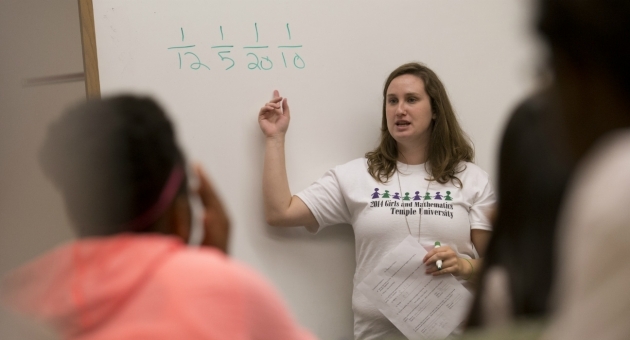Girls and Mathematics: Modeling success in the field

Although the gap has narrowed over the course of several generations, women continue to be significantly underrepresented in mathematics and science fields. Yet, if you look at the math and science performance of girls and boys in 4th and 8th grades, the differences between the sexes are, according to the National Science Foundation’s Science and Engineering Indicators 2014 report, “generally small.” Sometime during the tween and early teen years, boys and girls start to follow very different educational and career trajectories.
“Girls are good at math, but there is still a social stigma that hits them around middle school,” said Bridget Donegan, a Temple math major who is also an instructor at the university’s Girls and Mathematics Program. “At ages 12 and 13, girls’ standardized test scores drop and attitudes change.”
Directed by Mathematics Professor Irina Mitrea, the Girls and Mathematics Program is an intensive, one-week summer session for girls in grades 5 through 8. “The program is designed to support girls during a crucial transition point in their lives,” said Mitrea, who has been directing the program at Temple for three years. “We show that math can open up many career doors for girls and also let them meet very successful undergraduate and graduates students who use math every day.”
The program included 9 Temple student instructors drawn from the departments of mathematics, chemistry and physics as well as the College of Engineering.
“I love math and science,” said Donegan, a native of the Allentown, Pa. area. “There is so much talent in these girls, I want to see it grow.”
The 52 girls who participated in program learned how to do card tricks, not with magic, but with math and logic. They participated in the Game of Life, a cellular automaton developed by mathematician John Conway. The game consists of a grid of cells which, based on a few mathematical rules, can live, die or multiply. Students can use the game to model the genetic variations of zebra stripes, for example. Other activities included taxicab geometry, origami polyhedra and mathematics Jeopardy.
Sarah El, a seventh grader from Greenfield Elementary School in Philadelphia, thought the program was a good opportunity to improve her math skills. “I like taking all the steps needed to solve a math problem,” said El, who wants to be an agricultural scientist. “And I like math’s practical applications to real life.”
For Joy Hutchison, a seventh grader from Lower Moreland, Pa., math is an “opportunity to use your brain, that’s why it’s more fun than other subjects.” She wants to be an architect someday.
According to Mitrea, demand for math programs for girls is strong. “Whether its Girls and Mathematics, Math Circle or Sonia Kovalesky Day, the moment we get the word out about one of our programs, we are inundated with applications,” said Mitrea, who also designed a program for high-school girls that she offered at Brown University this summer.
“Families are looking for way to keep girls engaged and excited about mathematics and all the exciting career possibilities it opens for them,” she said.
-Greg Fornia